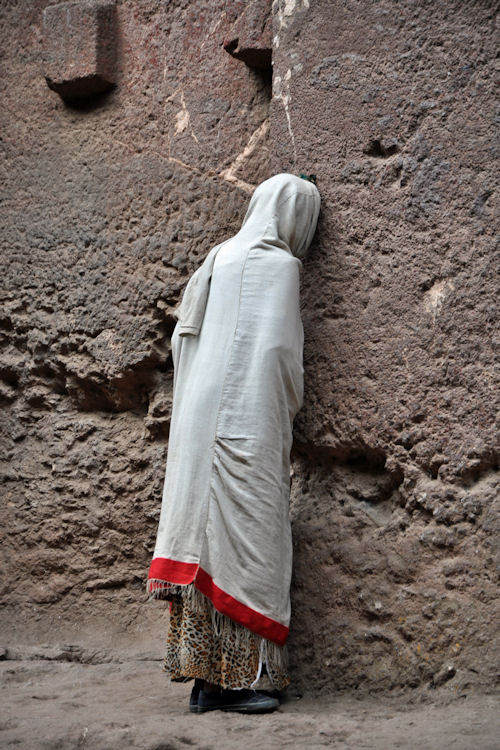

Ethiopia III Returned Peace Corps Volunteers
"Return to Ethiopia" Trip
September 22 - October 7, 2012
50th Anniversary of the Peace Corps in Ethiopia
September 30 - Sunday
The village of Lalibela is named for the most well known Zagwe king who lived from about 1185 to 1225.King Lalibela is credited for building the eleven famous rock-hewn churches in his capital city, known originally as Roha but renamed as Lalibela after his death (Prouty and Eugene 115-6). The Lalibela Churchers were not the first rock-hewn churches built in Ethiopia; churches that date two centuries earlier were constructed in Tigray (Pankhurst 49).
King Lalibela’s life is full of legends. It is believed that upon his birth, he was surrounded by a cloud of bees. Hence, his mother gave him the name Lalibela, which means, “the bees recognizes his sovereignty.” Our tour guide mentioned that the name also meant "honey taster." According to legend, he was commanded by God “to build ten monolithic churches (Henze 51).”
Numerous sites in Lalibela were given biblical names such as a stream called Jordanos and graves called Adam and Jesus Christ. This was an effort by the king to recreate Jerusalem, the Holy City, in his city, for Jerusalem had been captured by Muslims and pilgrimage for Ethiopian Christians had become difficult (Pankhurst 52-3).
The eleven rock-hewn churches are: Madhané Alam, Maryam, Bete Denagel (House of the Virgins Martyrs), Sellasé Chapel, Bete Golgotha, Mika’él, Amanu’él, Marquréwos, Abba Libanos, Gabr’él-Rufa’él, and Giyorgis. King Lalibela was buried in Golgotha (Pankhurst 49-52).
(Important note: All photographs, except where mentioned, are copyrighted as of October 8, 2012, by Darrel and Betty Hagberg. Please request permission to use and please credit them).
The undaunted Peace Corps tour groups preparing for their visit to the Lalibela Church Complex.
Priest at entrance to Lalibella Church Complex.
Our guide, Samson, describing the layout of Lalibella Church Complex..
Children watching with interest the tourists at the entrance to the Lalibela Church Complex.
Bete Medhane Alem Church, believed to be the largest monolithic church in the world.
Mother and child at Bete Medhane Alem Church in Lalibela.

Woman praying at the Bete Medhane Alem Church in Lalibela.
Bete Medhane Alem Church, believed to be the largest monolithic church in the world.
Window Detail of the Bete Medhane Alem Church in Lalibela.
Window Detail of the Bete Medhane Alem Church in Lalibela.
Bete Medhane Alem Church in Lalibela.
Priest at the Bete Medhane Alem Church in Lalibela.
The famous "Lalibela Cross" at the Bete Medhane Alem Church.
The famous "Lalibela Cross" at the Bete Medhane Alem Church.
Blessings given with "Lalibela Cross" at the Bete Medhane Alem Church. in Lalibela.
Blessings given with "Lalibela Cross" at the Bete Medhane Alem Church. in Lalibela.
Woman praying at the Bete Medhane Alem Church. in Lalibela.
Mother and child at the Bete Medhane Alem Church. in Lalibela.
Open graves at the Bete Medhane Alem Church. in Lalibela.
Bete Medhane Alem Church. in Lalibela.
Church of Saint George, Lalibela
Church of Saint George, Lalibela
Church of Saint George, Lalibela
Receiving a blessing at the Church of Saint George, Lalibela
Priest at the Church of Saint George, Lalibela
Church of Saint George, Lalibela
Priest at Church of Saint George, Lalibela
The Poinsettia Plant was introduced into Egypt in the 1860's from Central America and Mexico. It later made its way into Ethiopia where it can be seen growing in many places.
The Poinsettia Plant .
Tukuls located near the Lalibela Churches.
View from the Lalibela Church Complex in the highlands of Ethiopia.
Click below for more Photos of the trip
Click below for more Ethiopia Web Site features
Click here to contact the Ethiopia III RPCV Committee by E-mail with up date information:
Ethiopia III Official Web Site
Copyrighted 2011, All Rights Reserved.
Betty McLaughlin Hagberg, Web Master
Updated on 7 November 2012